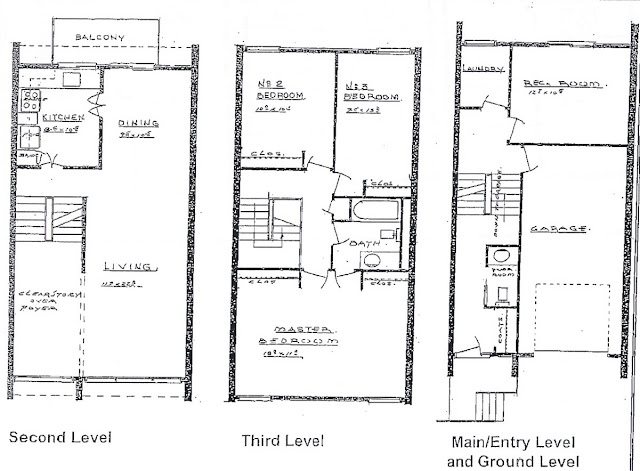Located in east Ottawa, in what once was Gloucester, is the neighbourhood of Pineview. Set northwest of Blair and Innes Roads, the area hugs the Pine View Golf Course, with easy highway access to the 417 and 174.
When the area was first developed in the 1950s, it was known as Seguin Heights (Maxime Street and Aurele Street). During this time the area was constructed by smaller builders and by owners who contracted to build their own homes. The Seguin Heights name was phased out and replaced with Pineview when the area began to boom in the 1970s. The focus of this blog post will be the developments starting during the boom period c. 1970, up until the end of the 21st century.
I have the plans for many of these homes, but I am missing some. If you have any hiding away in your attic or basement, please let me know so I can share them.
Below is a map of the area (courtesy of Google Maps) where I have added the details of the various phases of development.
Pineview Estates by Wimpey Homes
Around 1970, the builder Wimpey started constructing homes in "Pineview". Later advertising referred to the neighbourhood as "Pineview Estates". The Wimpey-built homes can be found on Beaverpond Drive, Hallmark Place, and Appleton Drive.
The Ottawa Citizen, August 8, 1970
The Ottawa Citizen, January 4, 1971
The Ottawa Citizen, January 9, 1971
The floor plans below are from Wimpey's Blackburn Hamlet sales package, but the same plans were built in Pineview.
Pineview Estates by Chambers-Gagnon
An area also called "Pineview Estates" was built by Chambers-Gagnon. Unfortunately, I do not have these plans. They appear to have been built on the northern leg of Northdale Street and parts of Ridgedale Drive.
The Ottawa Citizen, April 9, 1972
Costain Homes
The houses on the southern leg of Northdale Street appear to be Costain models, but I could not find any note of this neighbourhood in their marketing. These plans are the same as those built in nearby Blackburn Hamlet and can be found on this blog post: Costain in Blackburn Hamlet
Pineview Court by GNC
Pineview Court is one of the earliest townhouse complexes to be built in the area. Constructed by GNC, they are located just southwest of Beaverpond Drive and Blair Road.
The Ottawa Citizen, July 6, 1973
Pineview Village by Cadillac-Fairview
Cadillac-Fairview begun constructing in "Pineview Village" in 1974 on Whittaker Crescent and parts of Stonehenge Crescent.
The Ottawa Citizen, January 10, 1974
The Ottawa Citizen, August 31, 1974
Ridgebrook Estates
Located on Eric Crescent and Ena Lane, these townhomes were built around 1974.
The Ottawa Citizen, April 13, 1974
Blair Court (Now Blair Estates) by Nelstar
The townhouse complex at the southwest of Blair Road and Meadowbrook Road has a sign titled "Blair Estates", but when the area was first constructed c. 1974 it was called "Blair Court". Unfortunately, I do not have the plans for these houses.
The Ottawa Citizen, February 16, 1974
Stonehenge by Minto
Also around the same time, Minto built their Stonehenge townhomes located on the eastern leg of Stonehenge Crescent. These plans can be found at this blog post:
1970s Garden Homes by MintoThe Ottawa Citizen, February 16, 1974
Stoneridge North by Mastercraft
Mastercraft built the Stoneridge North townhouses on the north side of Meadowbrook Road in the mid-1970s. There are similar townhouses along Ridgebrook Drive that may be Stoneridge South, but I could not find any marketing material on the area. Alas, I do not have these plans.
The Ottawa Citizen, February 5, 1976
Meadowvale by Mastercraft, with the Rental Conversion done by the Regional Group as Stone Gate Park
During the 1970s large areas of Pineview were built with townhouses. Most were condos, but some were also built as rentals. One such complex, originally called Meadowvale, was converted to for sale houses in 1999 by the Regional Group. These are located on the western leg of Stonehenge Crescent. I only have one floor plan, but I suspect that there are one or two others.
The Ottawa Citizen, January 9, 1979
The Ottawa Citizen, February 6, 1999
Eastcliffe Gardens and Saxony Glen by Assaly
In the early 1980s Assaly Homes built Eastcliffe Gardens at Birchmount Drive and Cedarcroft Place. Those plans can be found on the following post and scrolling down:
Assaly Homes This area has garden homes (townhomes), villas (quatroplexes) and link homes (linked by the garage). Scrolling down further on that blog post you will find the plans for Saxony Glen c. 1984, located on Saxony Crescent and Nordic Way in the south end of Pineview. Both of these Assaly areas appear to have been built with rental units, but as a part of a rental conversion boom in the 1990s, these are now individually owned.
The Ottawa Citizen, May 26, 1981
The Ottawa Citizen, July 2, 1981
The Ottawa Citizen, May 10, 1984
The Ottawa Citizen, October 29, 1991
Brookmill Estates and Brookmill on the Park by Perez
One of the larger tracts to be developed in Pineview is Brookmill by Perez c. 1981. These were built on both sides of the western leg of Meadowbrook Road. There are some larger/wider plans in this development that I am missing.
The Ottawa Citizen, April 4, 1981
A final phase was built on Progress Place, but I am missing the plans for these.
The Ottawa Citizen, June 28, 1986
I am missing information on a few sections of the area, namely:
- "Golfview Estates" on Ballard Court
- Carleton Condo Corporation #70 homes on Ridgebrook Drive. Are these Stoneridge South?
The final pockets of Pineview were completed in the 21st century. These include:
- Richcaft Homes's Appleton Lane, c. 2001, on Royal Gala Private and Blossomfield Court
- Townhomes on Laura Private, c. 2002, by Edmond St-Amour Contracting
- Campanale Home's Stonehenge Park, c. 2008, on Torovin Private



























































Comments
Post a Comment